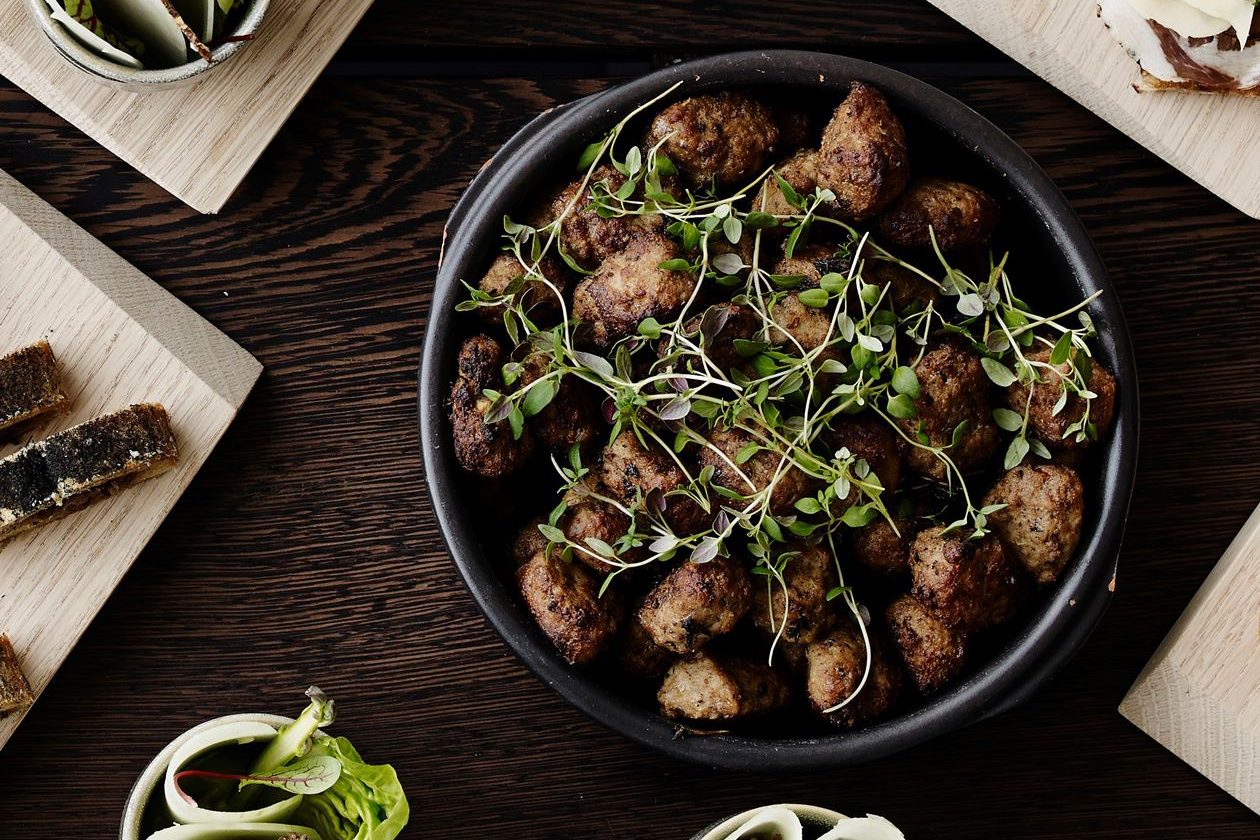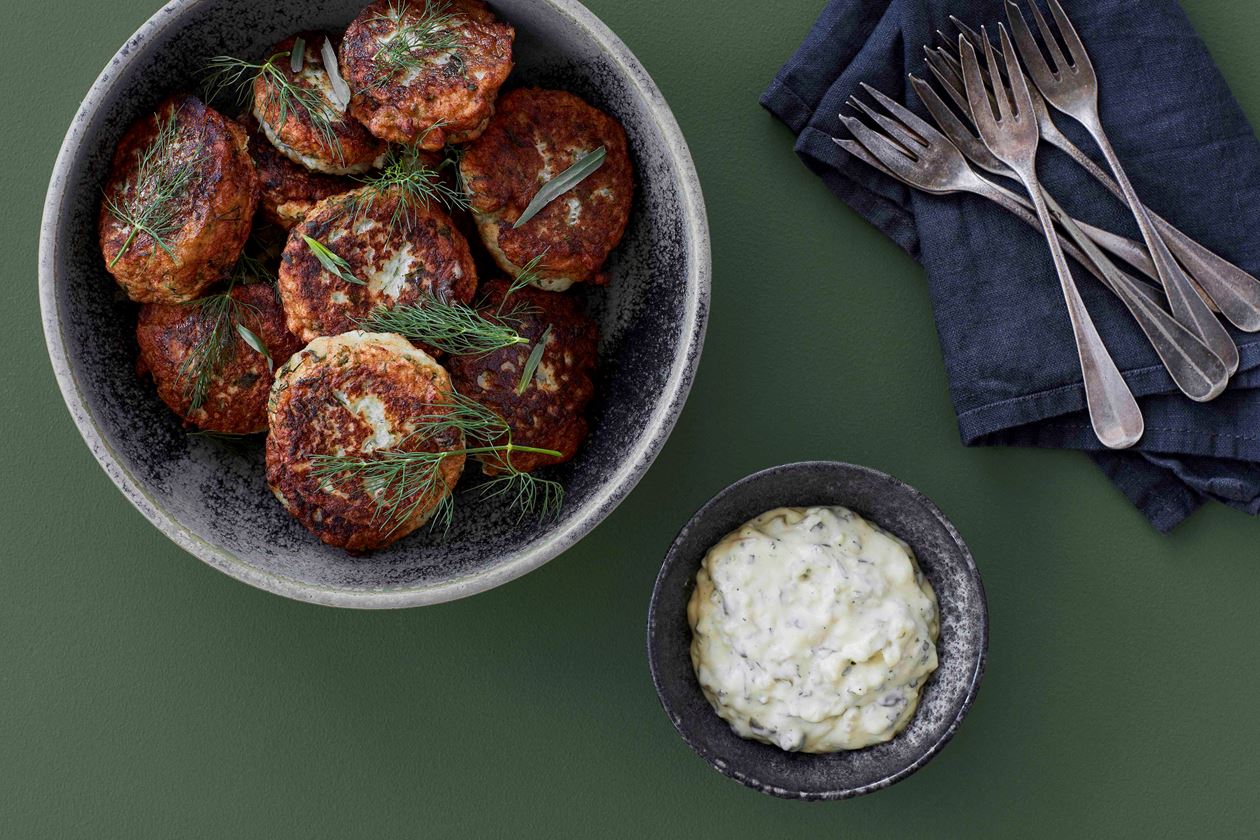“What should I eat in Denmark?” It’s the first thing friends ask, even before “What should I do?” or “Where should I stay?” in Copenhagen. It’s not surprising, given that the Nordic nation has gained quite the culinary following. When in Rome, as they say.
Denmark is home to dozens of Michelin-starred restaurants, including Noma – one of the best restaurants in the world. The country is also celebrated for its coffee culture, craft beer, flaky pastries, and open-face sandwiches. Who would’ve thought that this small, pork-and-potatoes nation would become a global gastronomic hub! But what exactly is famous Danish food?
Here’s a guide to answer every Danish-cuisine query. We’re talking national dishes, New Nordic, what to eat in Denmark, and what the Danes eat all year. Ready? Let’s dig in:
Country | Denmark |
National dish | Fried pork with parsley sauce |
Staple foods | Pork, potatoes, herring, rye bread, butter, cream |
Culinary claim to fame | The New Nordic Manifesto, Noma, craft beer, open-face sandwiches, Danish pastries (wienerbrød) |
Number of Michelin stars | 35 (as of the end of 2019) |
What is Danish cuisine?
Danish cooking is rustic and rooted in the peasant dishes made across the country before the Industrial Revolution. Before 1860, the majority of Danes lived off what they could catch, raise or grow meaning food was simple: rye bread, porridge, root vegetables, and preserved fish or meat for the harsh winter months.
Danish food culture started to develop as meat production grew and with the advent of the wood-burning stove in the late 1800s. It’s believed that many traditional Danish dishes actually originate from this time.
Frozen and fast food arrived from the 1960s, and Danes traveling around Europe started to bring back influences from Mediterranean and French cuisine with them. By the 1990s, southern ingredients were being farmed and imported to meet the demand for non-Danish tastes. Realizing that traditional Danish dishes and local older varietals of crops would be lost,
Claus Meyer and a group of prominent Scandinavian chefs wrote the New Nordic manifesto in 2004, committing to using seasonal and local produce.
Since this declaration, Danish cuisine has undergone a radical transformation to become the refined and simple cooking you’ll likely find in restaurants today. Although there are still plenty of pork-and-potato favorites knocking around too.
 | |
 | 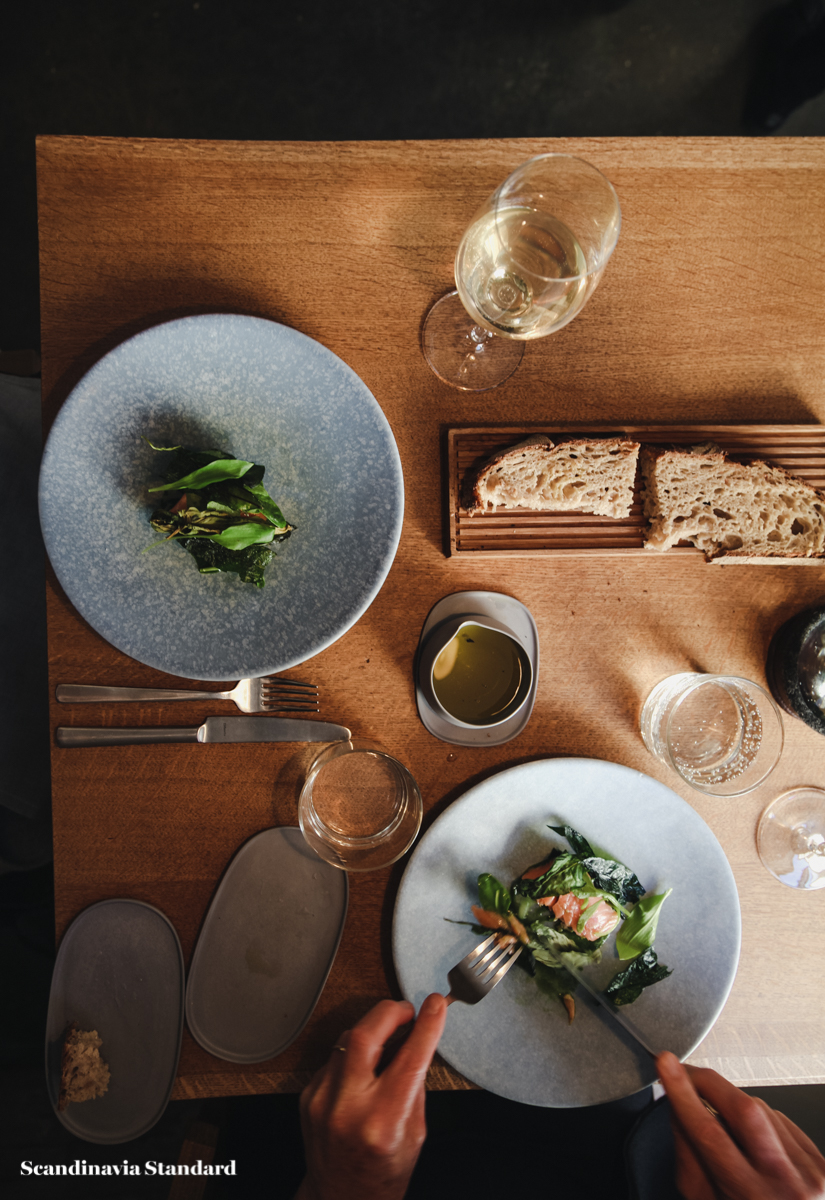 |
Top: Nomom; Left: Kadaeu; Right: Relae, Photography: Freya McOmish
Traditional Danish food
Stegt flæsk
Denmark’s national dish, stegt flæsk med persillesauce, is understandably beloved throughout the country. It consists of fried slabs of pork belly, served with boiled potatoes and a parsley béchamel sauce.
In addition to being a historical part of Danish gastronomy, the crispy pork has become the country’s go-to meal on election night. The practice of eating valgflæsk, or “election meat”, is a tongue-in-cheek reference to the (over)promises made by politicians on the campaign trail.
Flæskesteg
Typically consumed on, but by no means limited to, Christmas dinner, flæskesteg is the Danish version of roast pork. It’s heavy on the crackling (crispy fat) and usually served with boiled and caramelized potatoes (more on that later), and red cabbage.

Flæskestegssandwich
Slightly less traditional but just as delicious, the flæskestegssandwich takes a cold cut of the afore mentioned roast pork and puts it in a burger bun, along with red cabbage, gherkins, and of course, crackling. Some places smother them in brun sovs, a rich meat sauce similar to a gravy.
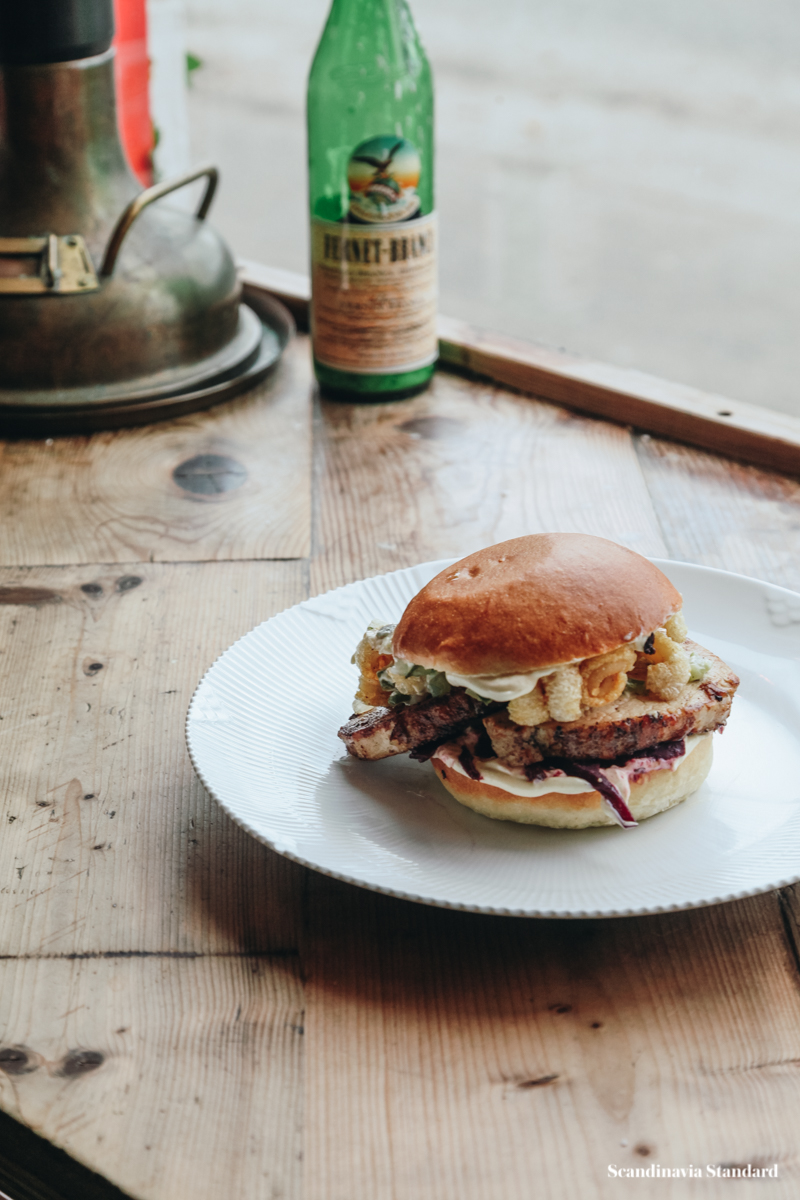 |  |
Oysters
Alright, you got us, oysters aren’t technically “traditional” culinary canon, but the wild Danish Limfjord oyster is something of a celebrity. Their wild colony in northern Jutland is among the last left in the world. The oysters are slow-growing, resulting in a firmer texture and more complex taste. How many other oysters can call themselves “the best oysters in the world?”
 | 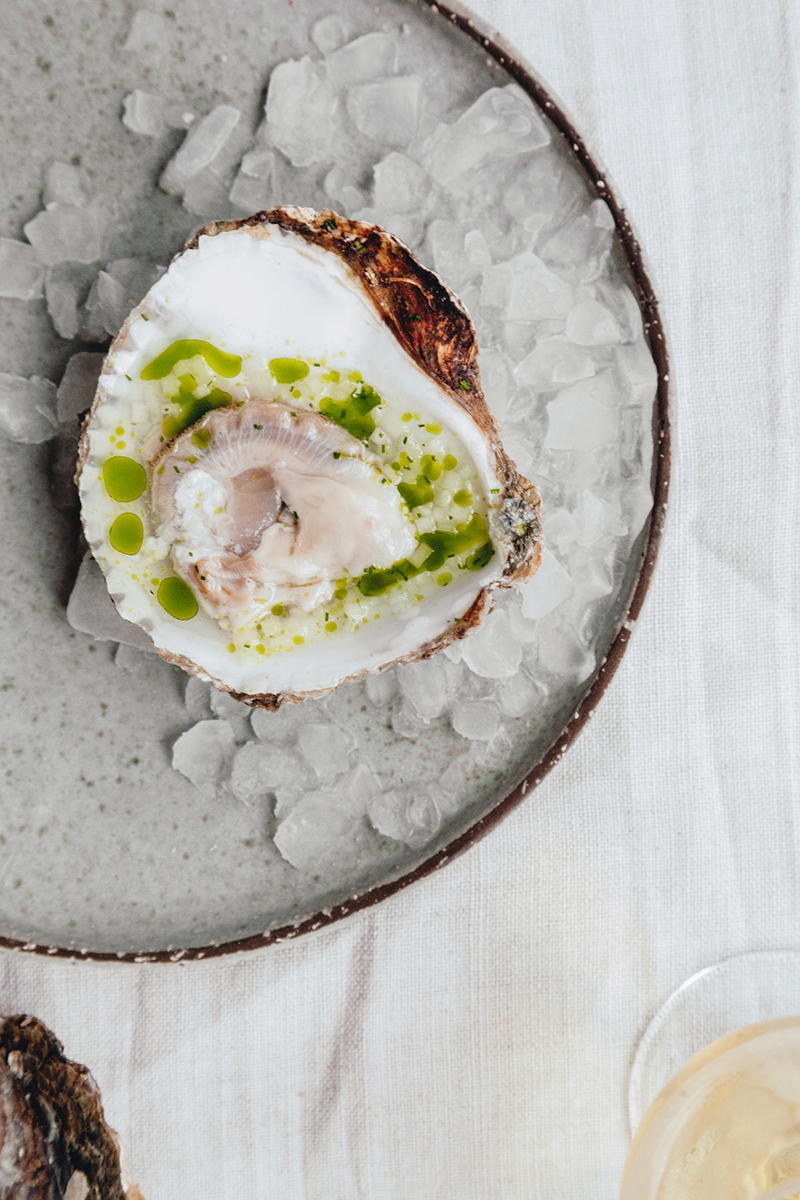 |
Tarteletter
Get to the office canteen a minute too late at lunchtime and you’ll be met with an empty tray where this popular dish once stood. Tarteletter are a flaky pastry cup, filled with all sorts of creamy concoctions.
The tarteletter med kylling og svampe – consisting of chicken, mushroom, and cream – are so popular, they were in the running for Denmark’s national dish!

Brændende kærlighed
Mashed potatoes topped with fried onions and bacon. The name literally means “burning love,” which is enough to give you an idea of how the Danes feel about it.
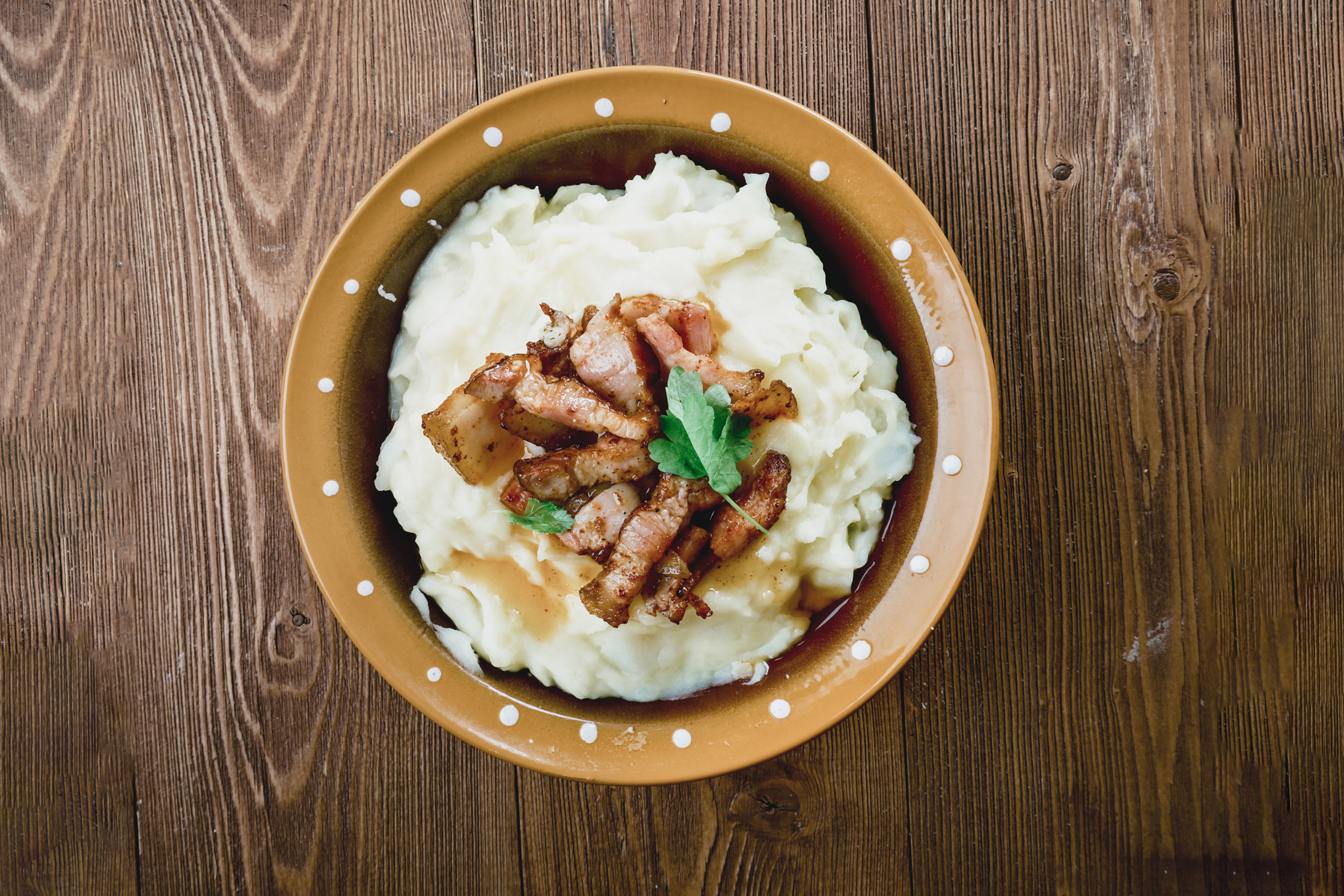
Smørrebrød
Denmark’s signature open-face sandwich. Smørrebrød is a slice of buttered bread piled high with goodies like fried fish, potatoes, or leverpostej – a type of liver pâté. A lunch-only dish, there are strict customs around topping pairings and the order in which they are eaten, plus regional variations to explore around the country. Don’t let the misnomer of “sandwich” confuse you, smørrebrød is very often a knife and fork affair.
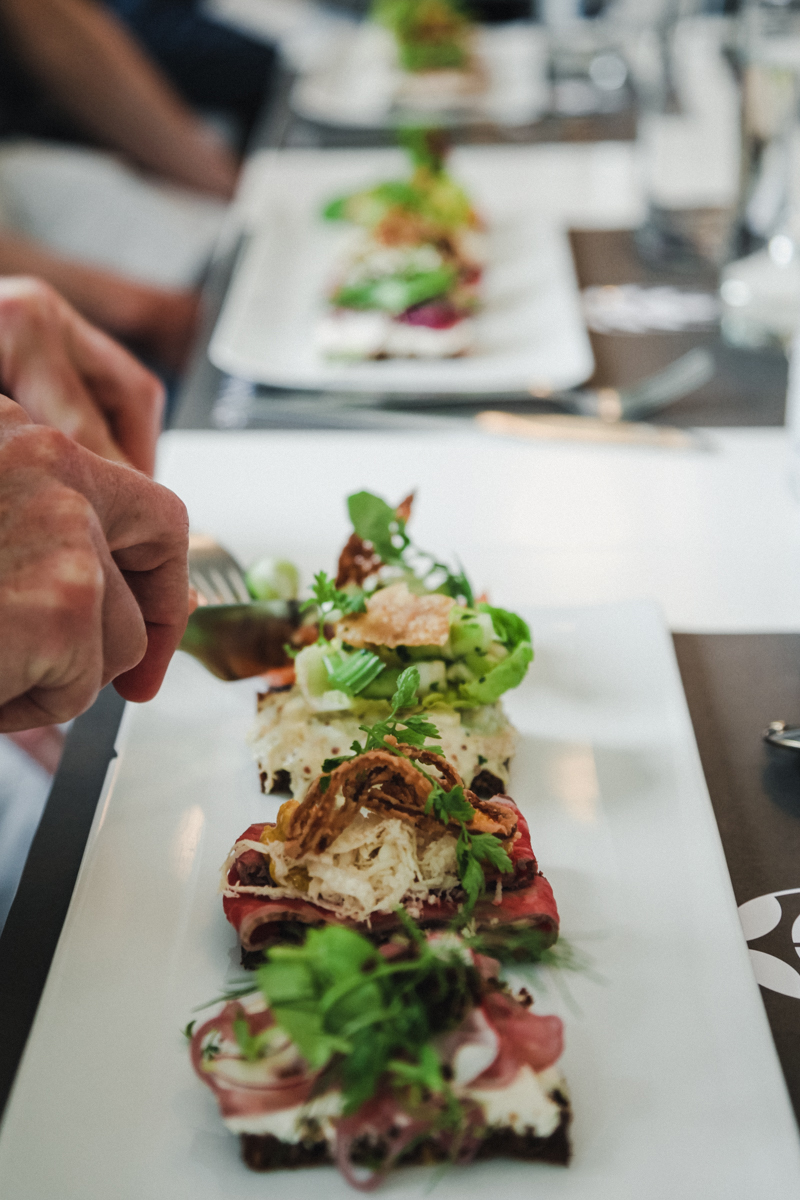 | 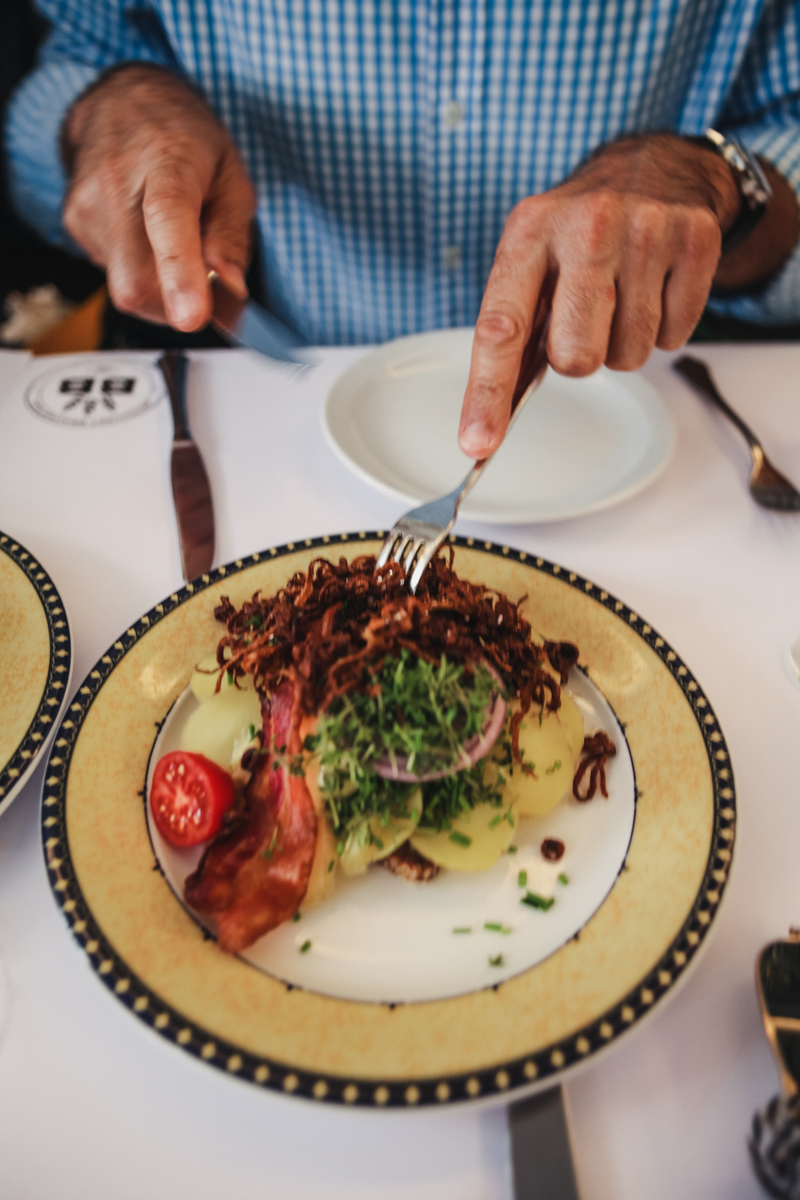 |
Frikadeller
These “Danish meatballs” are a blend of veal and pork, fried in butter – what else? They’re eaten atop Smørrebrød, alone as a snack, or with potatoes and sauce for dinner.
Fiskefrikadeller
The frikadeller’s fishy cousin. The fish version, fiskefrikadeller, is similar to a fish cake and can occasionally be found atop a smørrebrød.
Rugbrød
The famous Danish rye bread. It’s dark, dense, slightly sour, the foundation of most open-face sandwiches, and what Danes miss most when abroad.
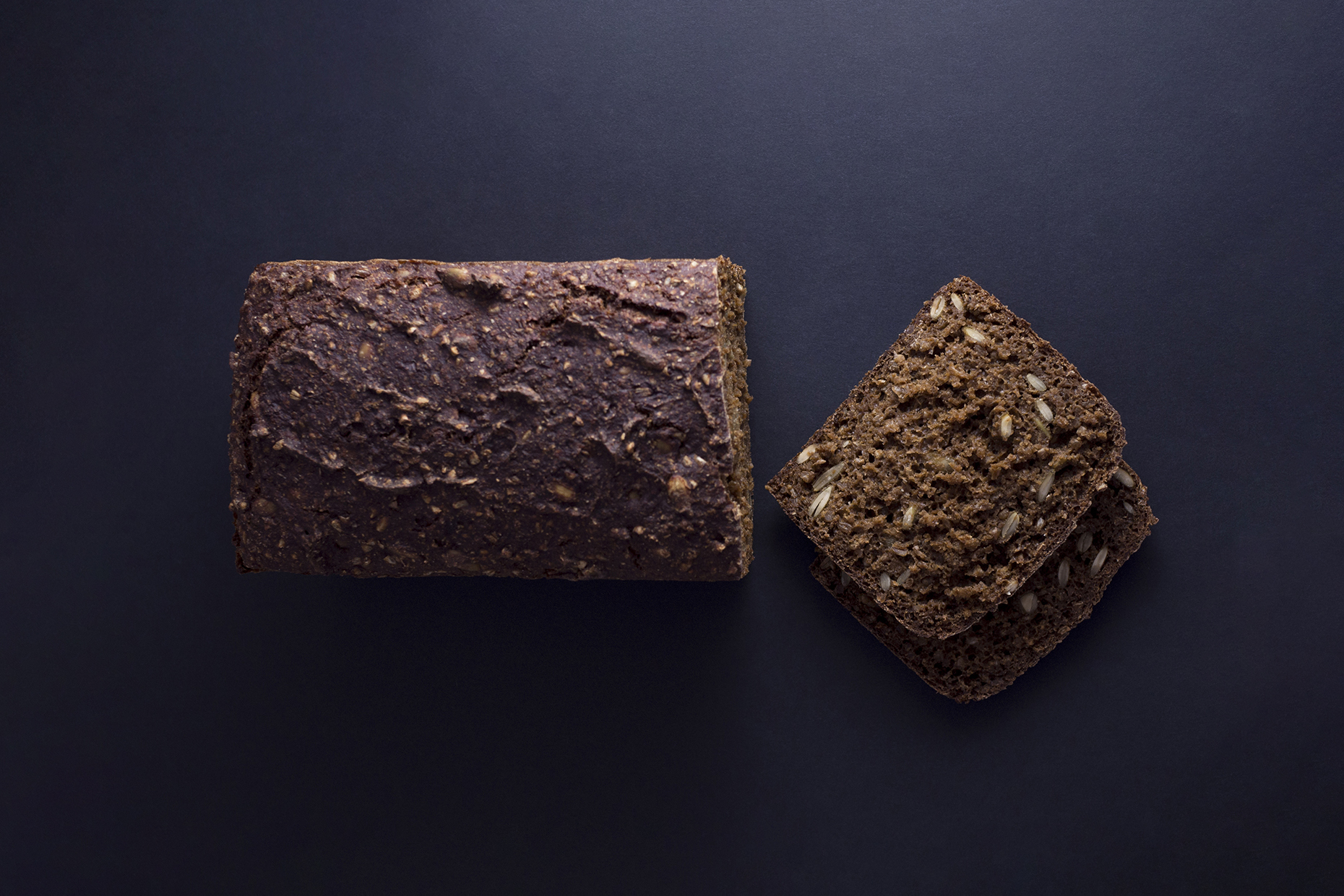
Sild or Pickled herring
Cured and preserved fish is a staple of most diets forced to endure harsh winters, but the Danes have elevated this acquired taste to a truly delicious delicacy. Popular versions include a mild curry sauce or a cognac marinade.
While sild has a strong, distinctive smell, it is not nearly as overpowering as the smell of Surströmming. Sild is often served as a popular dish in Denmark and other Scandinavian countries, and it is typically Surströmmingenjoyed with bread, potatoes, and other accompaniments.
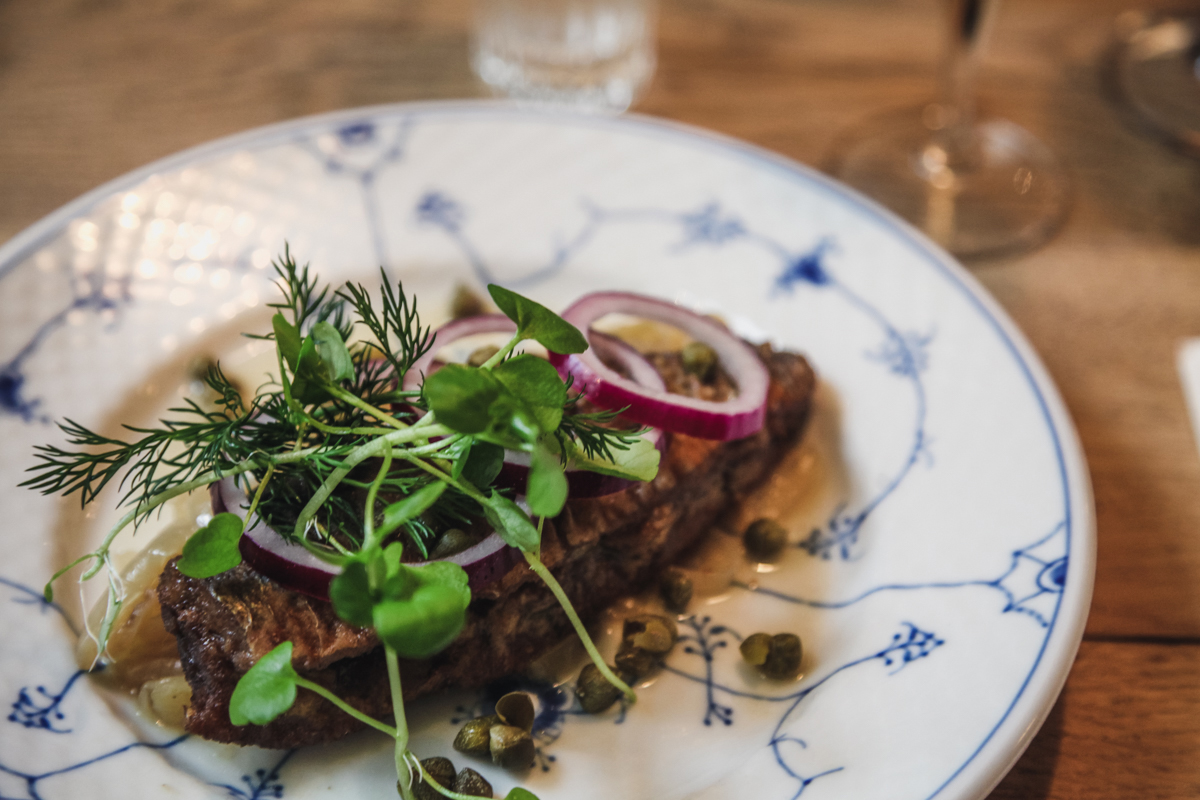
What should I eat in Copenhagen?
Aside from the above, if you’re visiting Copenhagen you’ll have a multitude of places to try – many of which will deviate from traditional bodega grub.
Hot Dog
In a land of Michelin-starred restaurants and cucumber mousse, the humble Danish hot dog is still on the top of our list of food to try. Why? Because they’re incredibly tasty and have been an object of national pride for decades. The quintessential Danish ‘dog is a pork sausage topped with mustard, ketchup, remoulade, raw and fried onions, and slices of sweetly pickled cucumber.
No matter your sausage preference – roasted (ristet), wrapped in bacon, or boiled and dyed red (rød pølser) – nothing beats one fresh from a pølsevogn, or a “sausage wagon”, which you’ll see dotted around the city and maybe even a few being walked home late at night.

Durum Falafel
Enjoyed Danish bodega culture a little too much? Stop by one of the many durum bars, which are Copenhagen’s answer to late-night fast food, for a Turkish flatbread full of freshly made falafel. Doner kebab is, of course, available, but most Copenhageners opt for the vegetarian counterpart – it’s just more delicious.
A durum bar of note is Kebabistan, which even world famous chefs can’t keep away from. As noted by Esquire’s Food Editor Jeff Gordinier in his book Hungry: Eating, Road-Tripping, and Risking It All with the Greatest Chef in the World: “After enduring a tasting menu in Copenhagen, David Chang would predictably head straight for a late-night dive called Kebabistan for a gooey, salty heap of shawarma.”
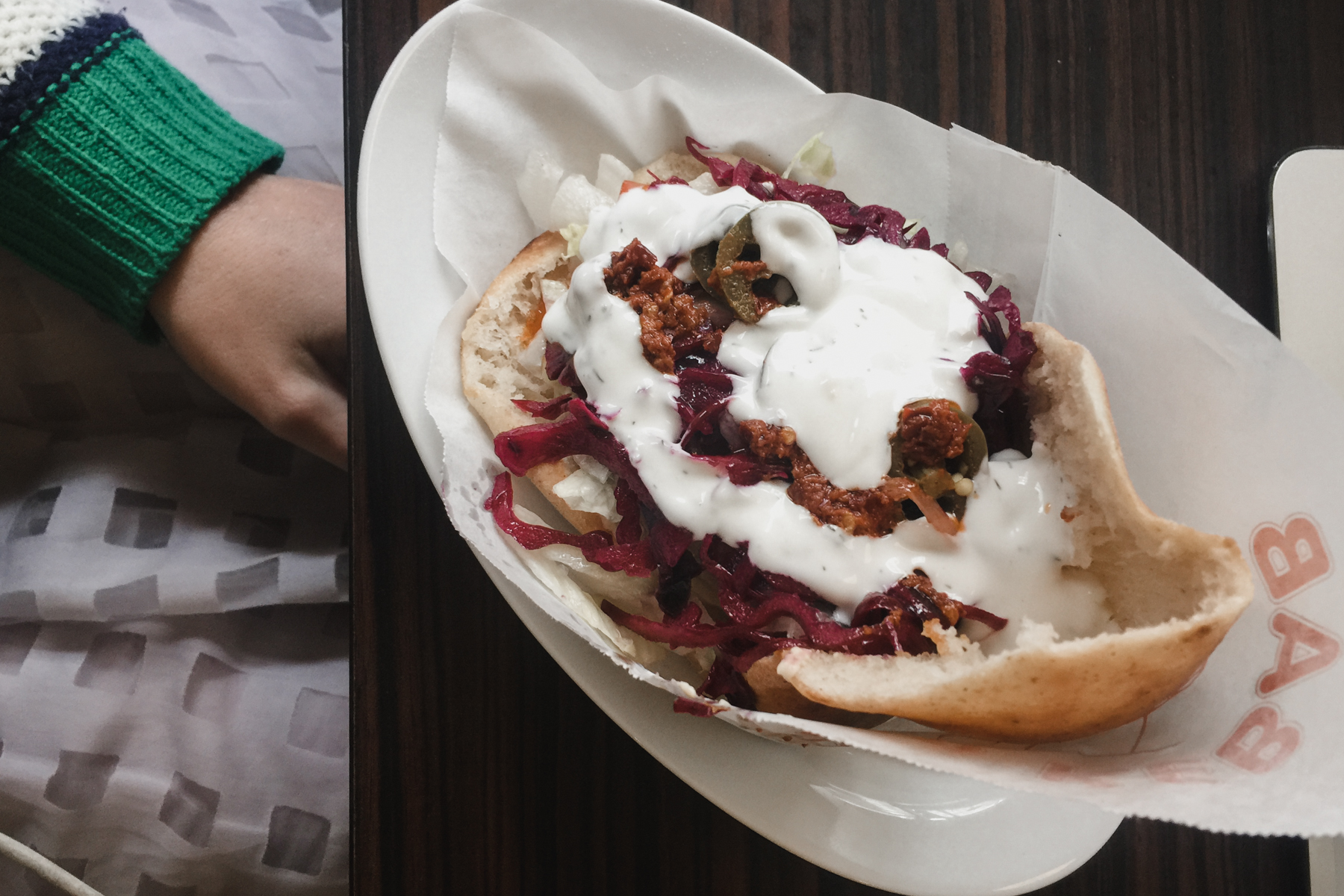
Pizza
It may seem counter-intuitive to travel to Denmark to eat Italy’s most beloved meal, but the pizza in Copenhagen can rival that of its home state. Don’t take our word for it? Multiple pizzerias in the city have placed on 50 Top Pizza‘s list for the best pizza in Europe, with BÆST, Luca, and Mother all included in the top 20. The numbers don’t lie, people.
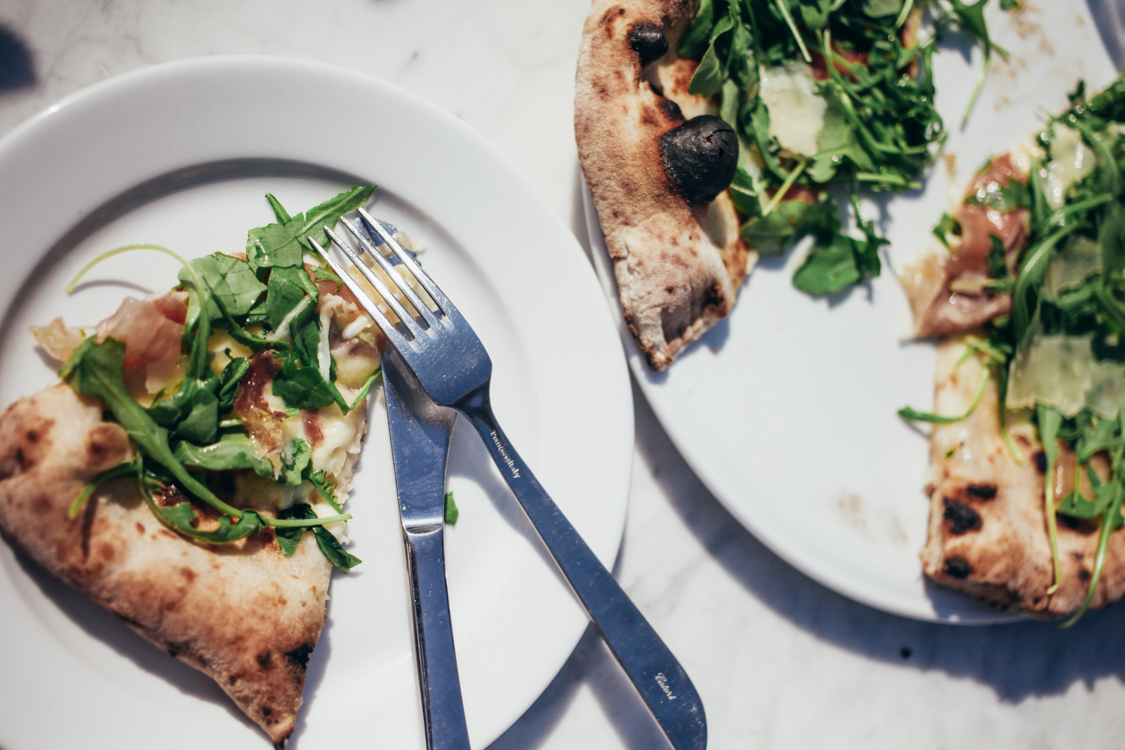
Delicious Danish Desserts and Sweets
Koldskål
So synonymous with summer, major Danish dairy producers project their sales of koldskål around the weather forecast. Koldskål is a mixture of buttermilk, eggs, lemon, vanilla, sugar, and yogurt or soured milk.
It’s either served as a drink or like a sweet soup, topped with crunchy biscuits (kammerjunker) and fresh strawberries. In summer, Danes eat it for dinner, dessert or as a snack. If you’re ever given a chance to try it, here’s a tip: don’t call it cereal.
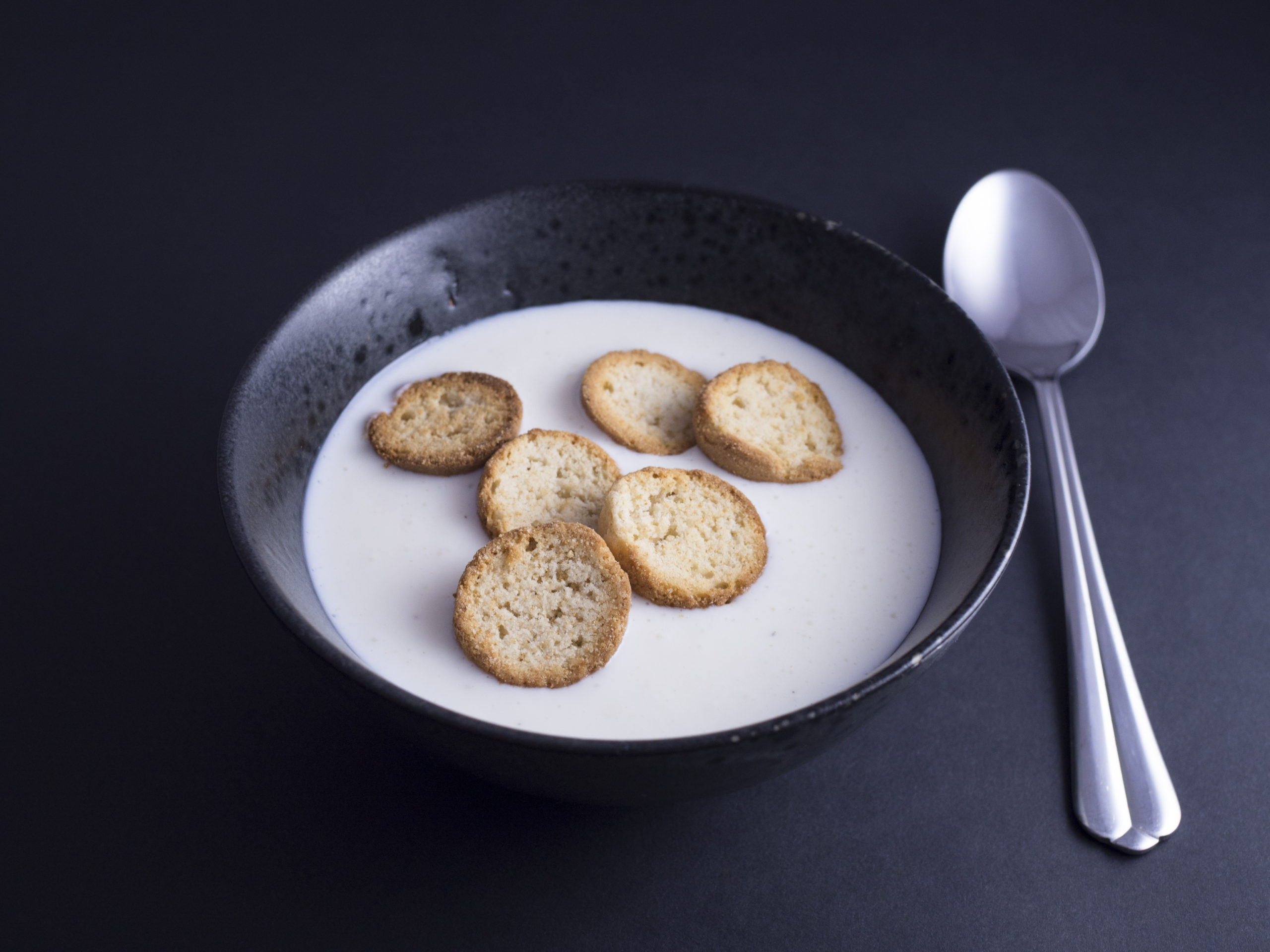
Rødgrød med fløde
A sweet dessert and a way to ritualistically haze non-native Danish speakers. The name translates to “red porridge with cream” and is so difficult to pronounce that foreigners are routinely asked to try. It’s made with a mixture of stewed red summer fruits, lightly sweetened and finished with whipped cream.

Licorice
Forget what you thought you knew about licorice candy; the Danish stuff is nothing like you’ve ever had before. The Danes love theirs with salmiak – a salt compound that has typically been reserved for cough medicins. It gives the licorice a salty taste, ranging from a slight tickle to a sensory assault. We recommend easing into the licorice craze with one of the popular artisanal brands: a chocolate or passion fruit dusting helps take the edge off.
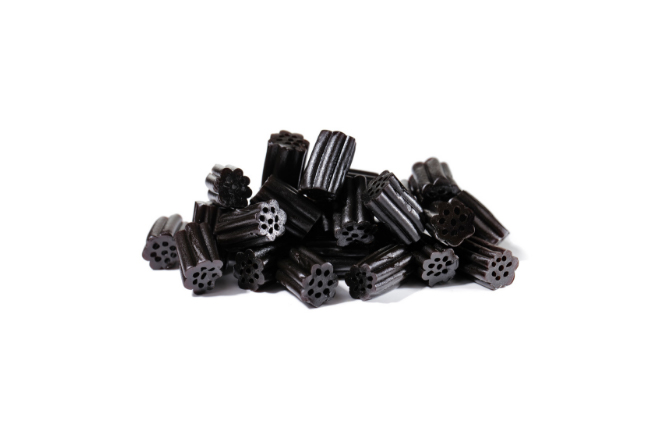
Æblekage
Although this looks strikingly similar to a trifle and there is no baking involved, this afternoon treat is referred to as an apple cake. It’s made of layers of stewed apples, crushed almond cookies, and heavy cream, which, when left in the fridge, solidifies to the point that you can have a heaped slice with your coffee.
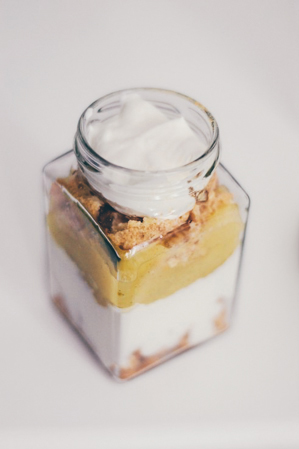 | 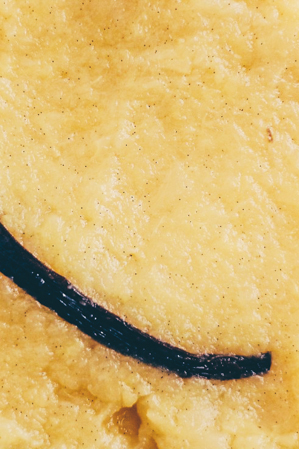 |
Romkugler
A sticky, truffly, chocolaty ball that’s oozing with rum and covered in sprinkles. These are hugely popular and you’ll find them in every bakery, as they were at one time a way for bakers to use up any leftover pastries!
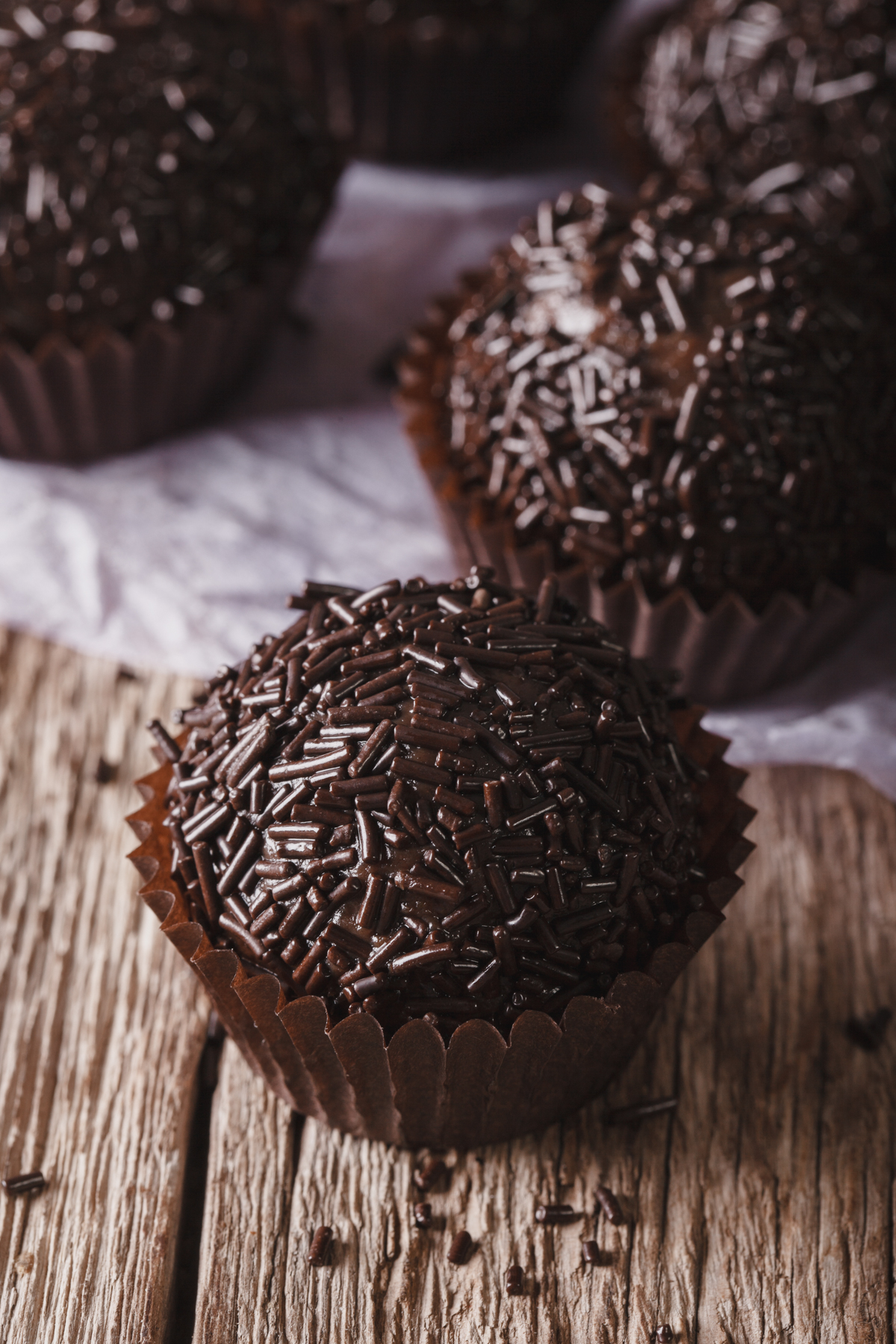 | 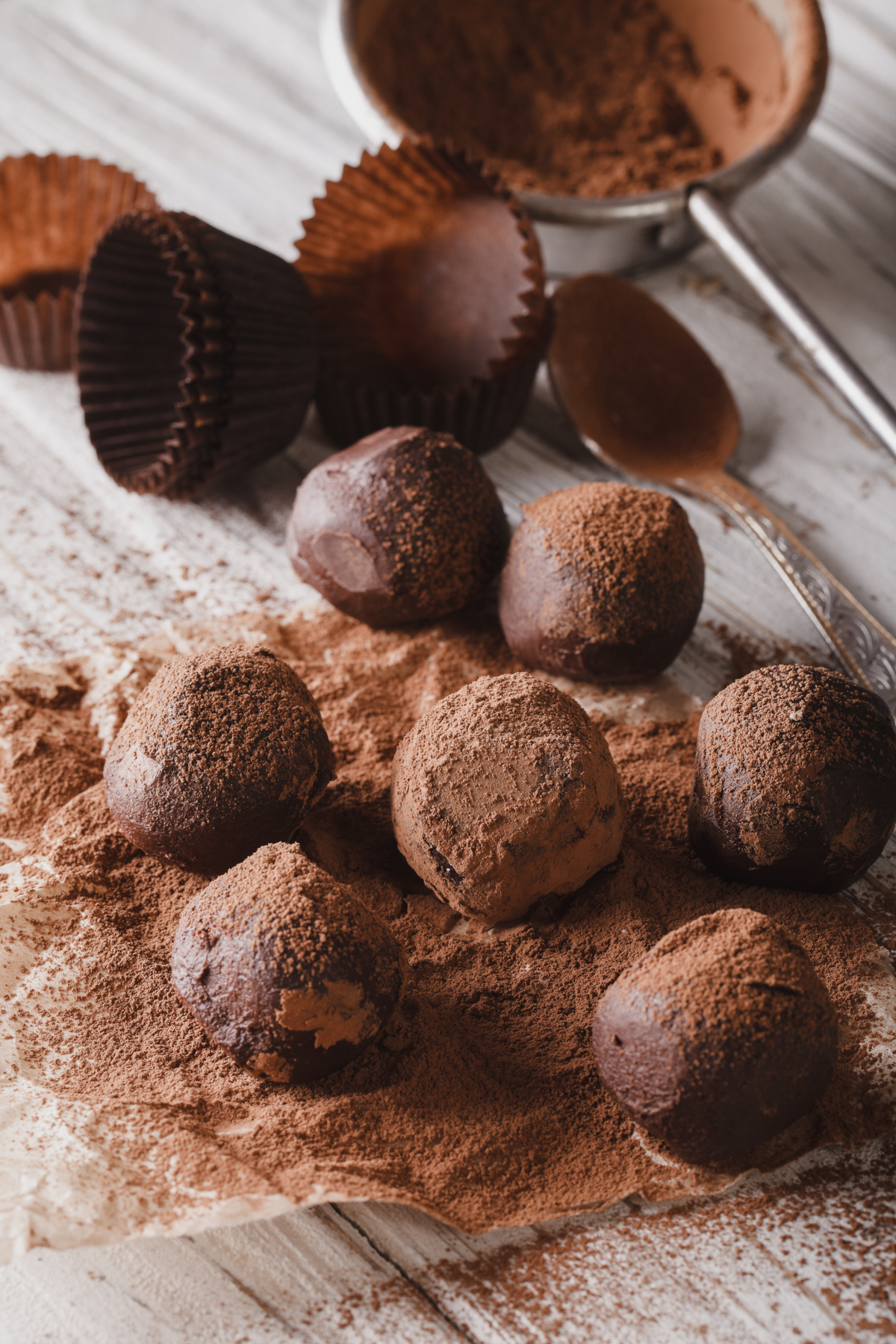 |
What do the Danes eat for breakfast?
Wienerbrød
In Denmark, wienerbrød or ‘Vienna bread’ is the umbrella term for a range of laminated, sweet pastries. If you’re from the US or UK, you’ll probably know them as a “Danish pastry,” or just a “Danish,” but they come in far more forms that the vanilla crown the name evokes. Every bakery will carry them, and there’s no shame in trying every single one. In fact, we highly recommend it.
Among the most sought after are the buttery cinnamon rolls (kanelsnegle), savory poppy seed buns (te birkes), and custard crème spandauer.
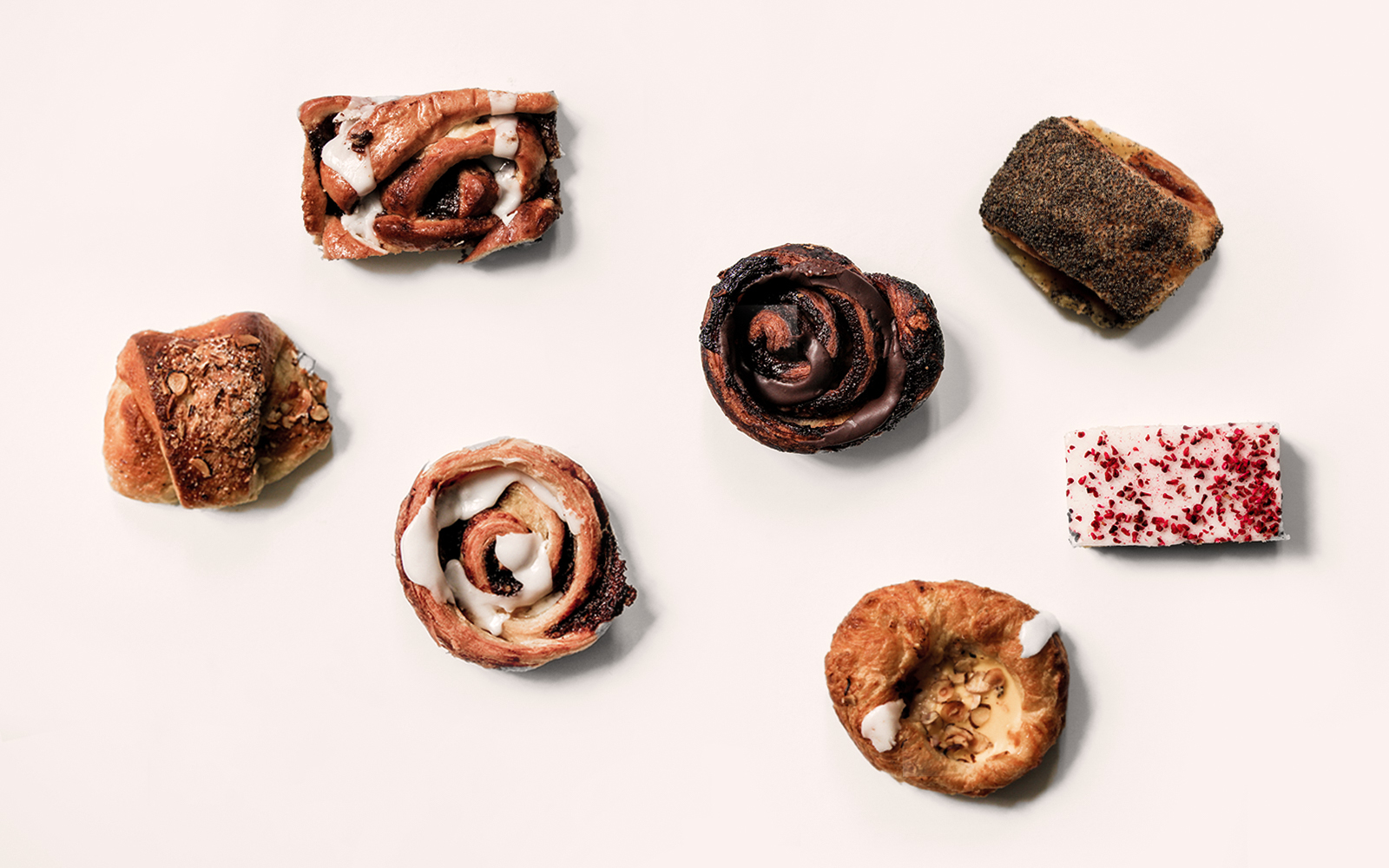
Øllebrød
Literally meaning “beer bread,” this is an old Danish porridge. Originally a poor man’s dish meant to fill bellies and use up leftover bread, it’s now more of an artisanal porridge with aromatic spices and tropical fruits. The classic Mormors øllebrød is made with rye bread, white beer, lemon rinds, and a pinch of sugar or honey. There’s also an old varietal with salted herring. You’ll either love or hate its tangy flavor, but there’s only one way to find out…
rugbrød med ost
A quintessential Danish breakfast you’ll likely find in any Copenhagen café, comprised of Danish rye bread with slices of cheese. Sometimes it’s served with jam, a boiled egg, or even two types of bread. No matter, it’s a charming breakfast plate to enjoy over candlelight in a hyggeligt café.
Morgenboller
For a breakfast on the go, the Danes head to bakeries for these morning rolls – your favorite loaf made portable and usually stuffed with butter and cheese.
What do Danes drink?
beer
There’s more to Denmark than the brewing-behemoth, Carlsberg. Since the early 2000s, micro-brewers have stepped out from the icon’s shadow and today, Denmark boasts some 200-plus craft breweries. There’s nothing micro about the flavors, however, as beers range from hoppy to infused sours to unfiltered white wheats.
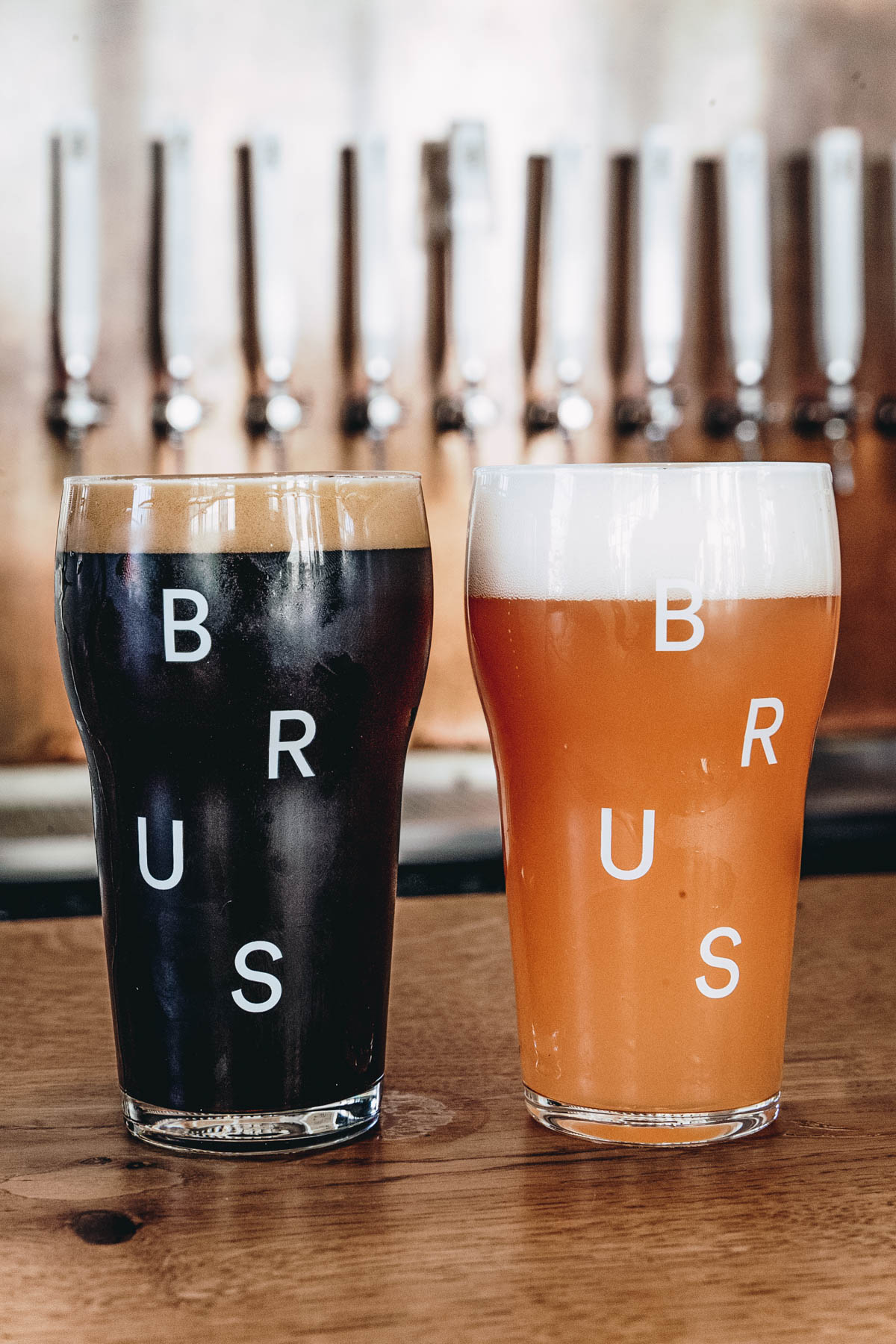 | 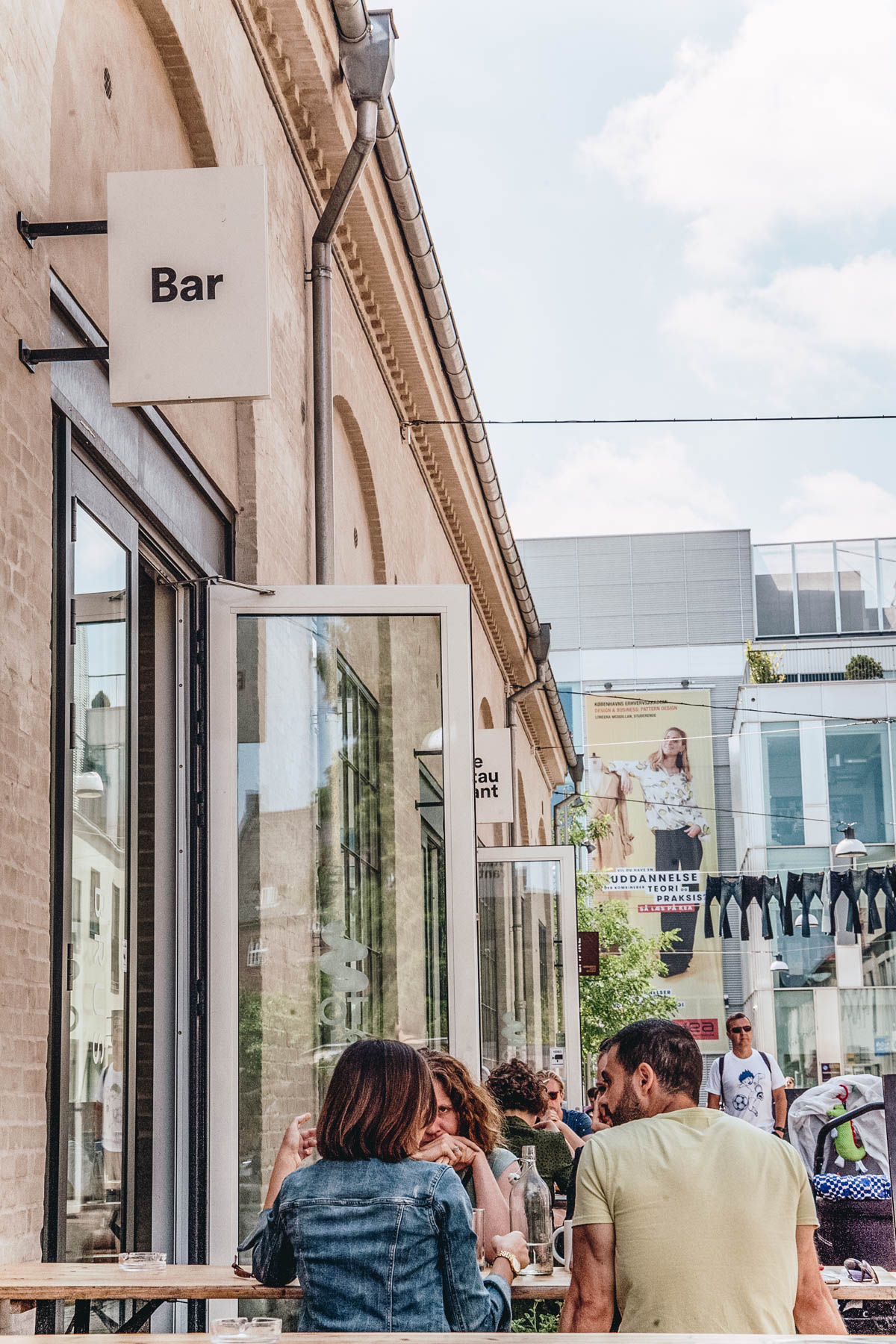 |
Faxe Kondi
Is it a lemonade? Is it a sports drink? The Danes don’t care, as they go wild for this retro drink. Originally developed as a sports drink in the 70s, Faxe Kondi was a collaboration between three Danish national sports teams, Dr. Knud Lundberg, and the Faxe Bryggeri brewing company. It tastes like the Scandinavian cousin of Sprite, if Sprite tasted like Faxe Kondi.
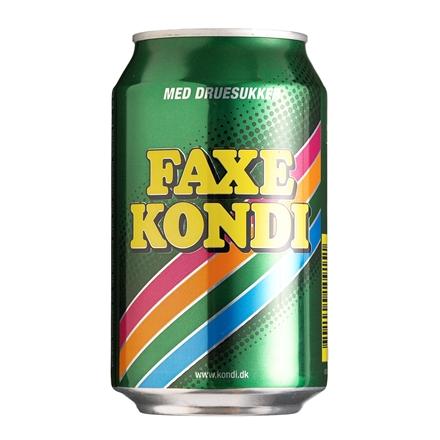
Coffee
The Nordic countries are the biggest consumers of coffee on the planet, drinking upwards of four cups a day. In Denmark, non-competitive, independent houses dominate the coffee market, thanks to the specialty coffee movement of the early 2000s. This all sets the stage for an incredibly strong coffee scene where ethical sourcing, micro-roasting, and cool sipping spaces are the norm.
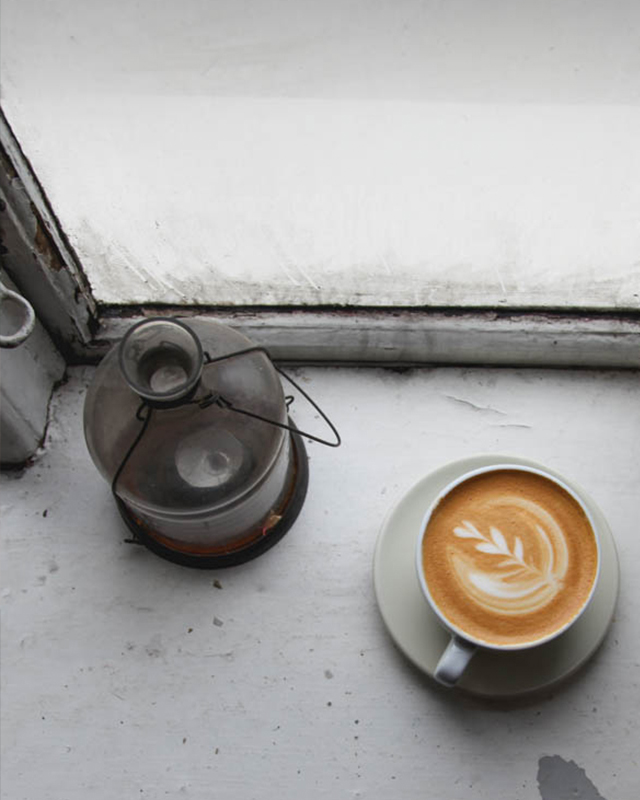 |  |
Saft
Saft is a concentrated drink of boiled fruits, typically berries, and sugar. In Denmark, elderflower (hyldeblomst) and black currant (solbær) are the popular flavors. They’re typically sold in glass bottles and are diluted with water before drinking. A local favourite is Bornholms Mosteri.
 |  | 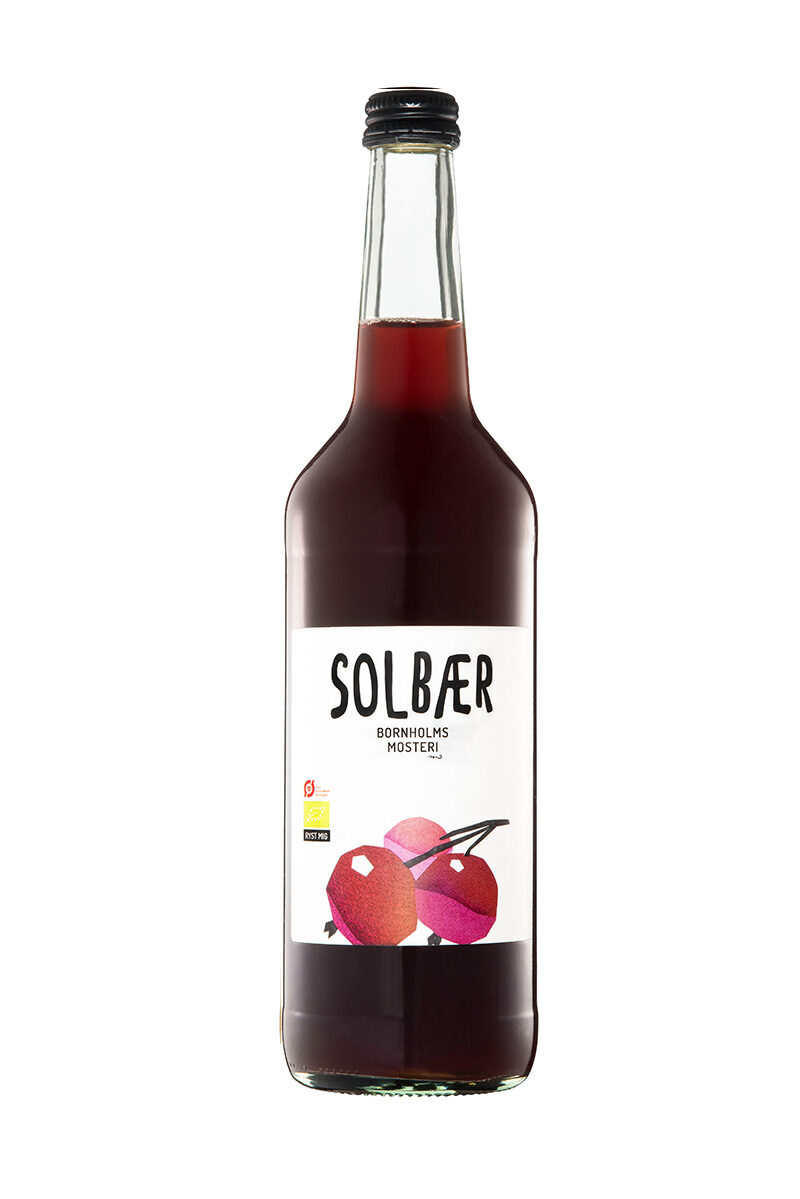 |
Snaps
Love it or hate it, prepare to drink a lot of it during the holidays… In Denmark, snaps is the same as aquavit: a Scandinavian alcohol distilled from grains and potatoes and infused with caraway and/or dill. It’s poured as a shot and sipped with a meal. It packs a punch, but you really can’t beat a shot of blackthorn infused snaps with a smørrebrød lunch.
 | 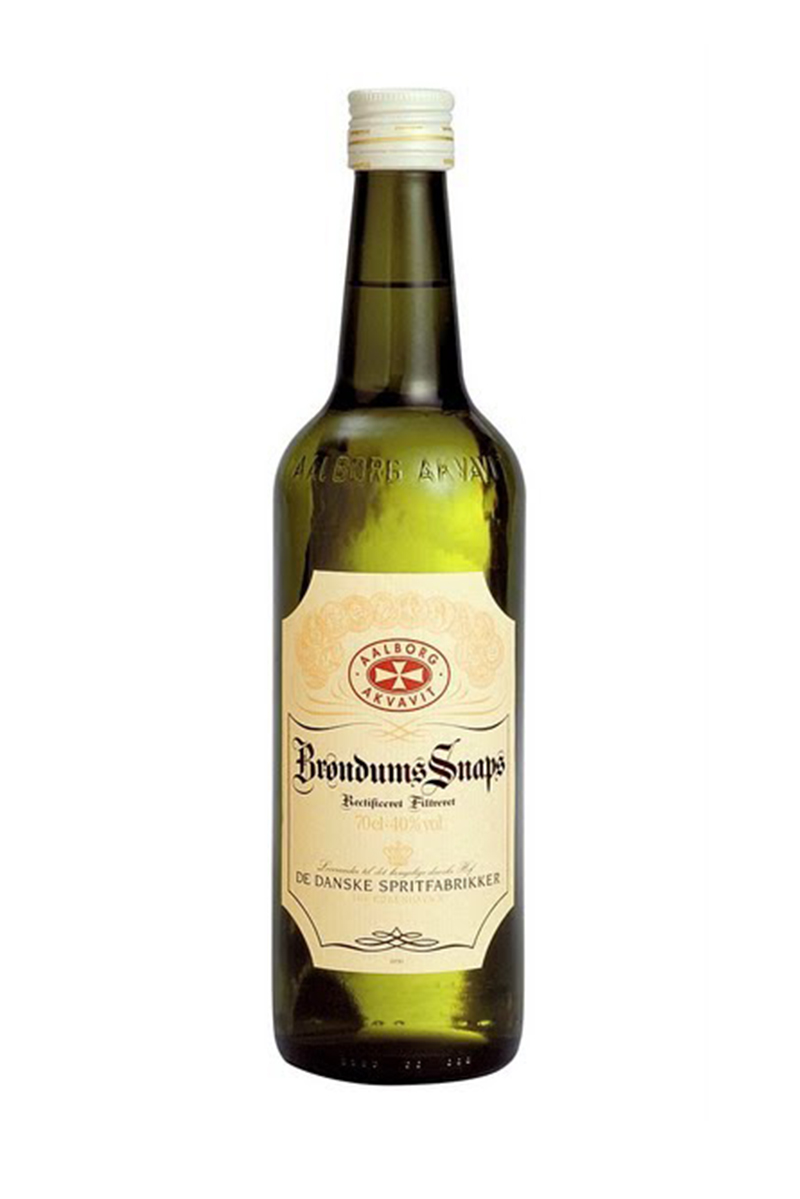 | 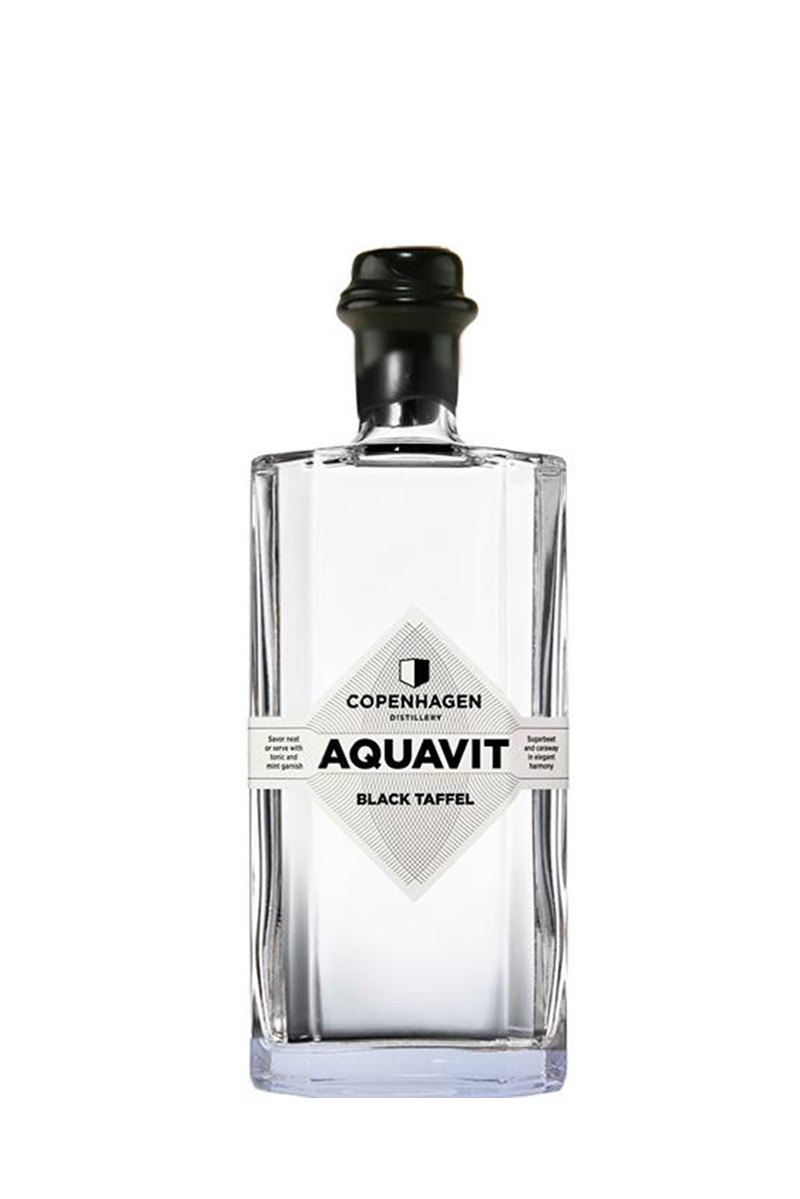 |
Gammel Dansk
A spirit typically enjoyed with festivities and surprisingly in the morning, it’s also seen as an old man’s drink – the kind of thing you Farfar would order. It’s a bitter matured with spices, herbs, and flowers, which was created to rival foreign bitters such as Fernet Branca in Denmark.
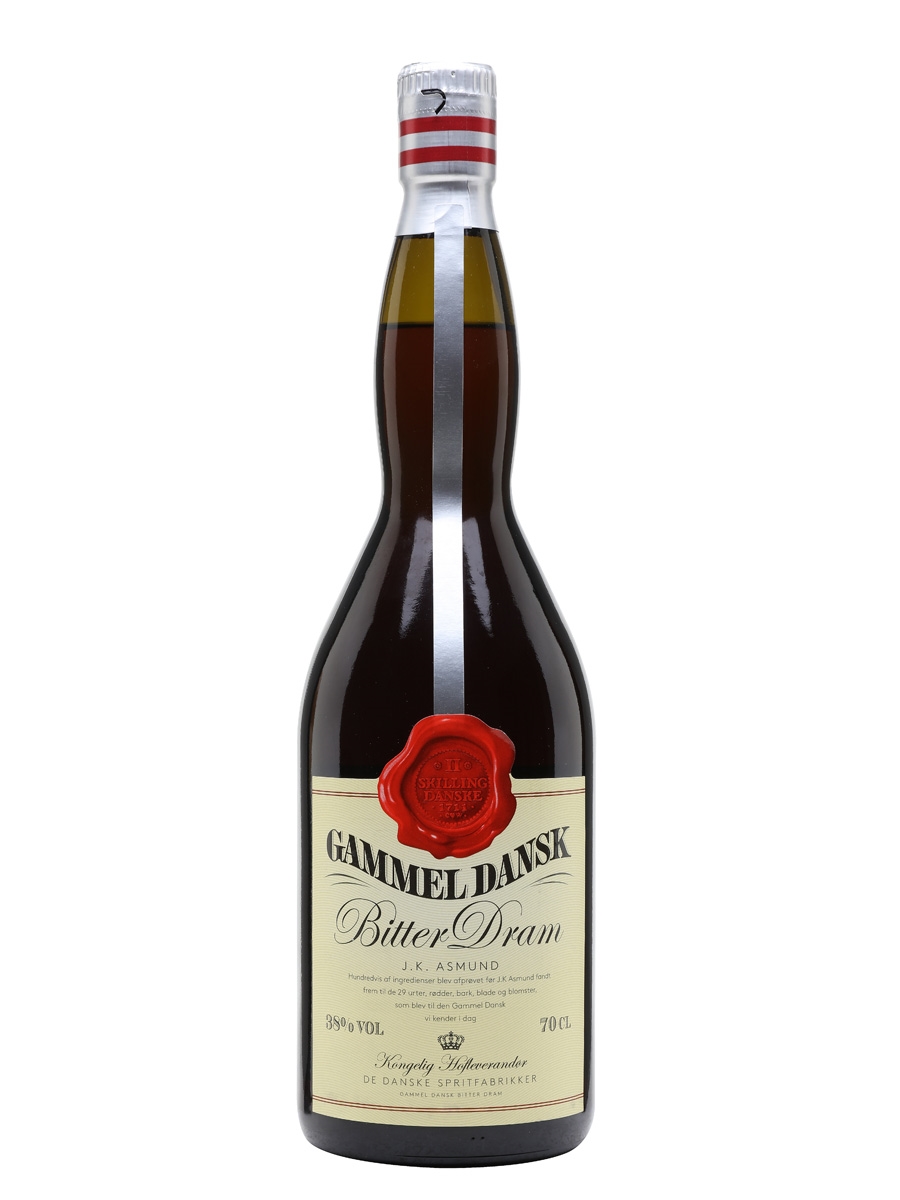
Gajol
The unofficial “get the party started” shot, made of licorice-infused vodka in various flavors. Some bodegas serve the green apple shot topped with whipped cream. It’s definitely an acquired taste.
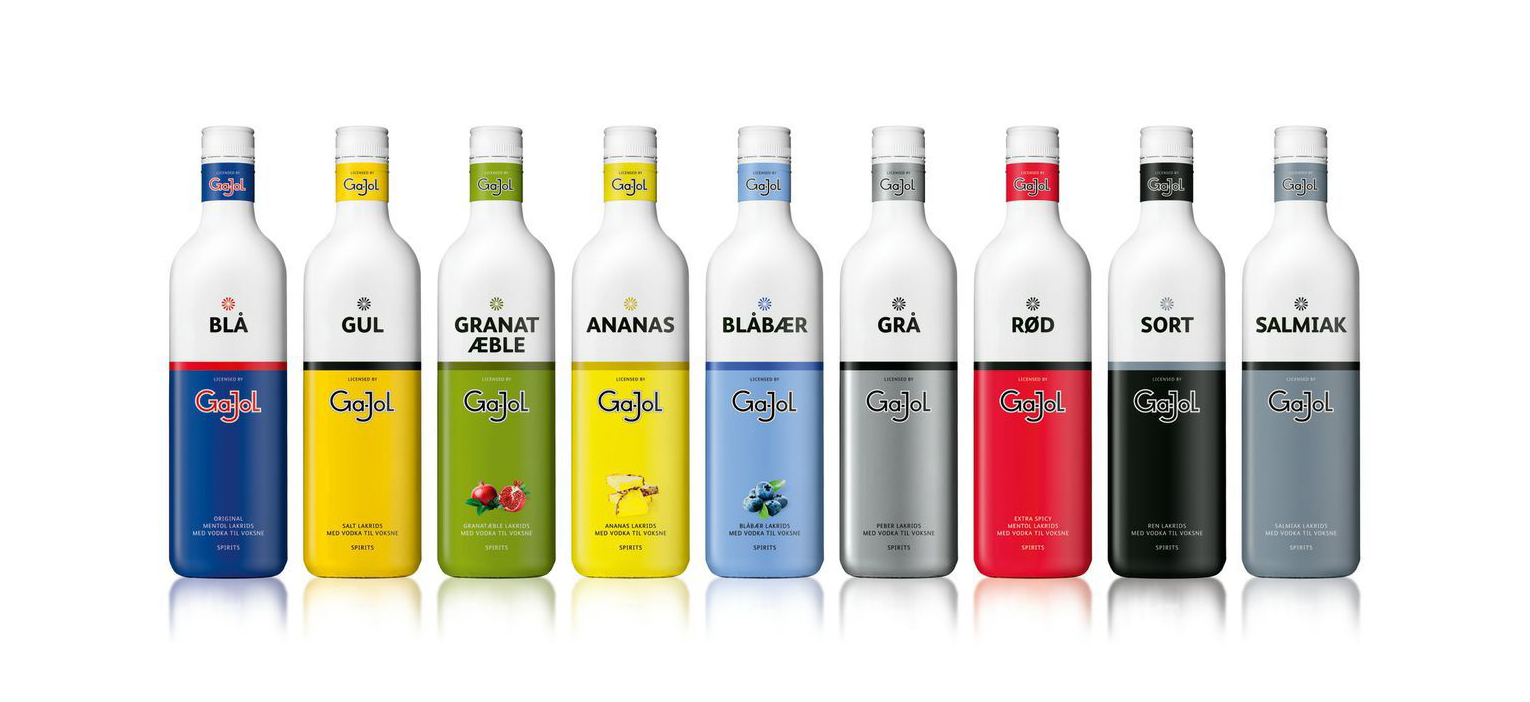
Fisk
A vodka-based spirit that mixes eucalyptus, menthol, and licorice. Tastes like a Fisherman’s Friend has been dissolved in vodka. Usually enjoyed ice-cold and as a shot at midnight.
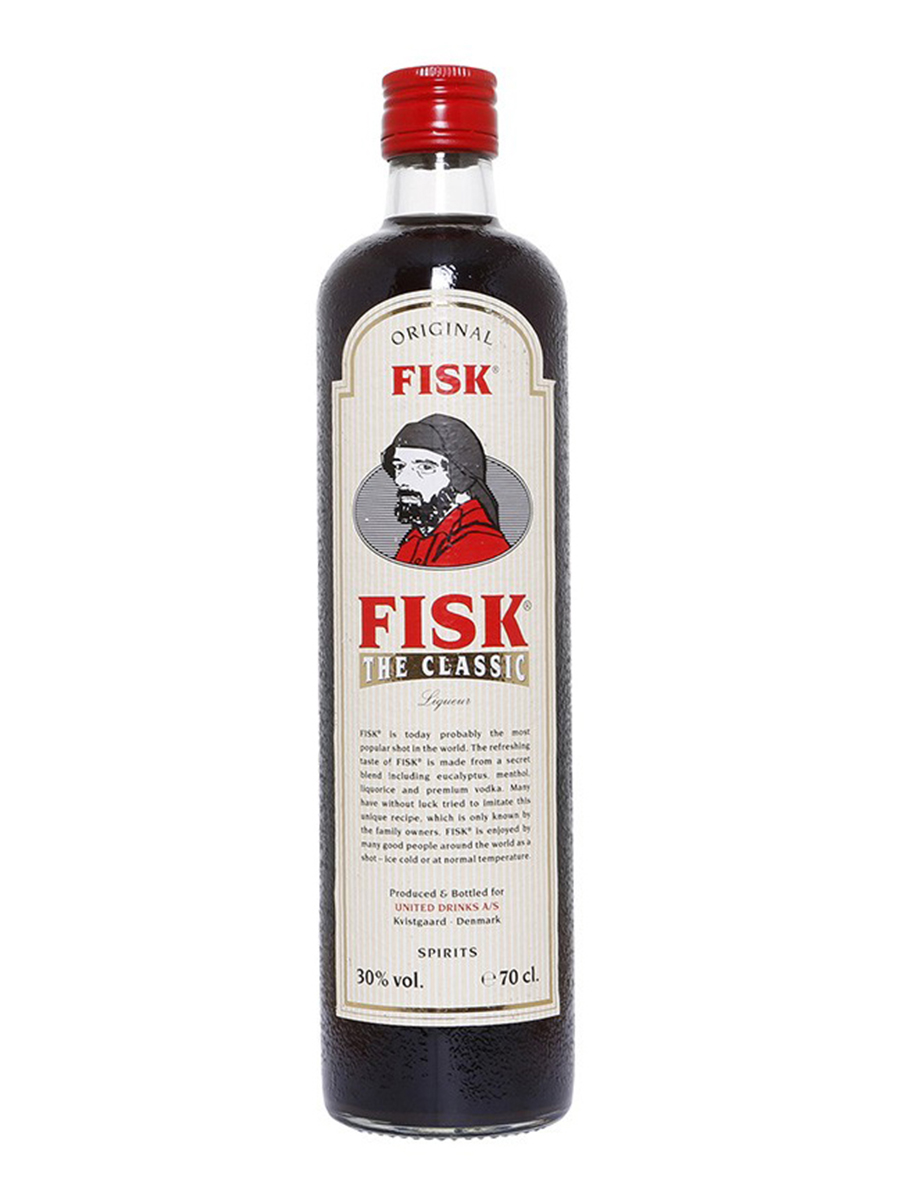
What is the New Nordic Movement?
The “New Nordic Kitchen” is a culinary and cultural movement that started in Scandinavia over 20 years ago. It emphasizes the use of local, seasonal ingredients and traditional, Nordic methods of food preparation. Purity, freshness, and simplicity are cross-cutting tenets, as are ethics and cooperation.
In 2004, the New Nordic Manifesto was created to outline the guiding principles of the movement. Danish chef and restauranteur, Claus Meyer, was the driving force behind the project that included other prominent chefs from across the Nordic countries.
Looking to find a spot to try Denmark’s culinary claim to fame? Take a look at our favorite New Nordic restaurants in Copenhagen!
Traditional Danish holiday foods
Denmark has quite a number of holidays that, besides disrupting the working calendar from March – June, include baking, frying, or boiling something delicious. When in town, we recommend giving them a try!
Fastelavn
Found in the run-up to Fastelavn, the Danish equivalent of Halloween or Mardi Gras. Most of Scandinavia gets into the carnival spirit with a round bun filled with cream. The classic versions, gammeldags fastelavnboller, aren’t overly sweet and are topped with a little powdered sugar glaze. In Sweden, they’re called semla and contain an almond paste. But Danish-specific variations of fastelavnboller are typically a light pastry bun with a whole host of good stuff going on: fruit filling, chocolate tops, and glazes notwithstanding.
When: | Fastelavn is the Sunday before Ash Wednesday, but fastelavnboller are available from late January. |
Easter
In Denmark, Easter Sunday is celebrated over a lavish lunch that includes multiple hot and cold dishes. Lamb is typically served for the hot dish, while det kolde bord, or “the cold table,” is full of smørrebrød favorites like curried herring and pork liver pâté. Tartletter will probably make an appearance, the meal usually starts with a fish course, and, naturally, there’s plenty of eggs.
Every year, Tuborg releases its seasonal Easter beer: a golden brew, adorned with sweet cartoon chicks, which the Dane’s fondly refer to as Kylle Kylle. Expect to see these and plenty of snaps around the table.
When: | The exact date can get tricky as it involves the moon, spring equinox and a church decree. As a general rule, Easter always falls between March 22nd and April 25th |
Store Bededag (Great Prayer Day)
Store Bededag is a Christian holiday created in Denmark to, ahem, more efficiently honor multiple saints in a single day. N.b. They take one day off to pray instead of six.
In the 1600s, bakeries would close in observance of the day, so bakers would make hveder – soft wheat rolls – for Danes to buy the day before. Hveder are meant to be eaten a little stale, toasted, with butter and jam. Nowadays, most bakeries stay open on Store Bededag, but the tradition of hveder remains.
When: | Store Bededag falls on the fourth Friday after Easter and hveder hit bakery shelves no later than the night before – though some start baking the week of. |
Sankt Mortens Aften (St. Martins Eve)
St. Martin’s Day recognizes the death of Martin of Tours, a bishop and the patron saint of soldiers and the poor. On the evening before his death, much of Europe eats a stuffed goose in his honor. Why? Because a gaggle of geese revealed Martin hiding to avoid becoming a bishop. Since it’s easier to cook a duck, though, the Danes make one of these instead.
When: | November 10th |
Christmas
There are so many Christmas traditions that we’ve written a separate article on what you need to get your Danish Jul on.
Christmas Eve dinner is super traditional; duck, potatoes, pickled red cabbage, and gravy. Caramelized potatoes tend to make an appearance at the table and if you’ve never had them, they can be a shock. There seems to be no rhyme or reason for them other than potato = good and sugar = good. Can two wrongs ever make a right? Maybe, if “right” means “sweet buttery potatoes.”
Risalamande is typically eaten for dessert. The cold rice pudding is topped with a hot cherry sauce and contains a hidden whole bleached almond, the finder of which wins a prize, but not before tormenting the other guests – traditionally you all have to keep eating until the almond is located.
Julefrokost, the actual Christmas Day lunch, is a marathon meal of cold fish, flæskesteg, roast pork with crackling, and lots and lots of snaps (we warned you). Æbleskriver, a pancake-like ball that once contained apples but now just comes with jam and sugar, and hard cookies are ubiquitous this time of year.
The whole season is kicked off by J-Dag, the day Tuborg releases its annual Christmas beer. If you’re in the city for it, you’re bound to see a few Tuborg-blue Christmas hats bobbing around.
When: | The first Friday in November – December 26th. |
New Year’s Eve
Typically spent at a dinner party, restaurants will offer takeaway dinners that can be assembled easily on the night. While the main meal may vary from home to home, everyone’s dessert will be the same. Kransekage, a cake shaped like a Fisher Price Rock-a-Stack, is as important to NYE celebrations as champagne. The tiered cake is built with discs made of almonds, sugar, and egg whites. A.k.a. a marzipan lover’s dream.
When: | December 31st |
Traditional and New Nordic Danish cookbooks
Looking to try your hand at some Danish cooking? Then give these essential cookbooks a read:
Noma: Time and Place
Not everyone can get a table at the world’s best restaurant but René Redzepi’s Noma: Time and Place will make you feel like you were there. It’s the kind of cookbook that one buys to lust after the gorgeous photos, as well as learn some incredible techniques and recipes.

Noma: Time and Place in Nordic Cuisine by René Redzepi, €70
The Nordic Kitchen – One year of family cooking
This comprehension cookbook has one intention: to make New Nordic cooking easy and accessible. The year’s worth of recipes are grouped by the seasons and include detailed instructions on how to handle foraged foods and tricky ingredients.
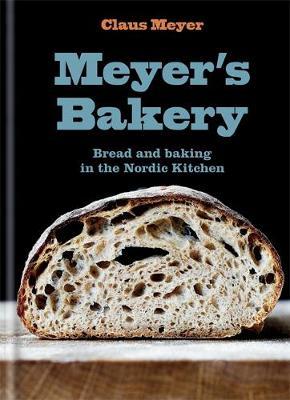
Meyer’s Bakery: Bread and Baking in the Nordic Kitchen by Claus Meyer, €23
Meyers Almanak
First published in 2010, this massive index of recipes comes straight from the godfather of New Nordic, Claus Meyer. This isn’t a fancy book though; it’s all about classic Danish recipes. No pictures, just step-by-step instructions.

Almanak by Claus Meyer, €54
Frøken Jensens Kogebog
With over 1,000 traditional Danish recipes, this comprehensive book has been considered seminal to Danish cuisine since it was first published in 1901. Almost every Danish kitchen has a copy and it definitely comes out around Christmas and Easter!

Frøken Jensens Kogebog, €54
Den Grønne Syltebog
Published in the 1930s by the Danish food producer Tørsleff’s “Housewife Services,” The Green Book of Preserving is still one of Denmark’s best-selling cookbooks. It contains 300 recipes on seasonal pickling and jamming. They’re all in Danish and worth the translating.
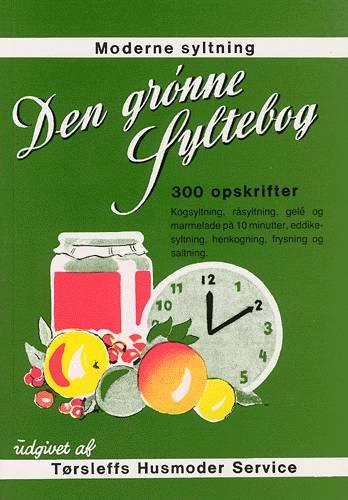
Den Grønne Syltebog, €6
Scandinavian Baking – Sweet and Savory Cakes and Bakes, for Bright Days and Cozy Nights
Trine Hahnemann is the queen of Danish cooking. A title earned after writing 10 immensely popular books on the subject. Scandinavian Baking is her comprehensive guide to traditional Danish baking, including breads, buns, cakes, and everything in between.
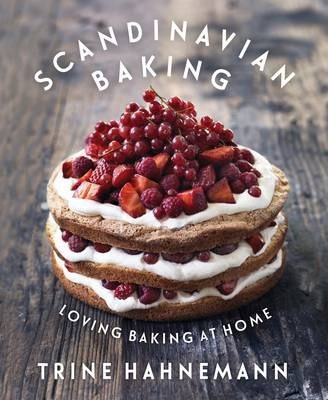
Scandinavian Baking: Loving Baking at Home by Trine Hahnemann
Want more Scandinavian food? Find out all about Swedish pancakes, Norwegian cuisine, and the world’s stinkiest fish.
Heads up! This post contains affiliate links. The commission we earn when you buy through our links comes at no extra cost to you. For more information about affiliates, please see our Disclosure Policy.


